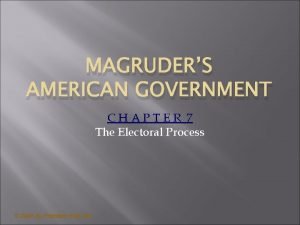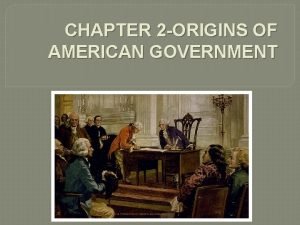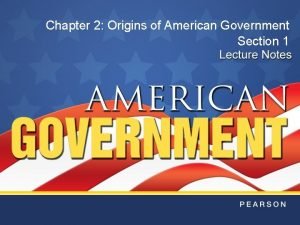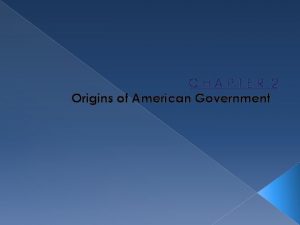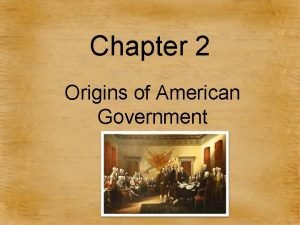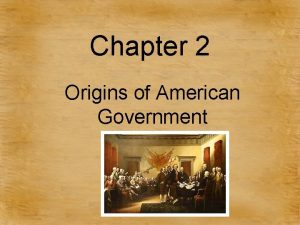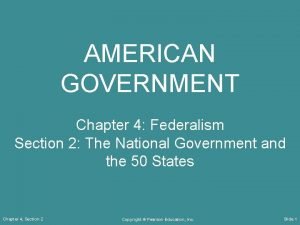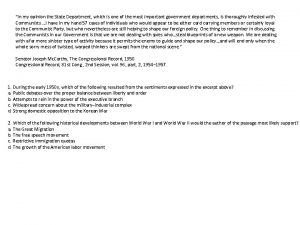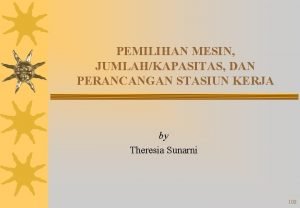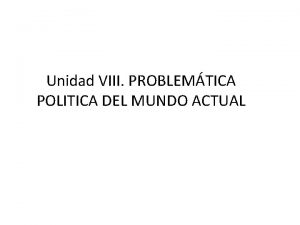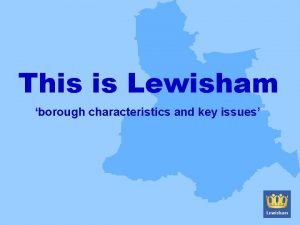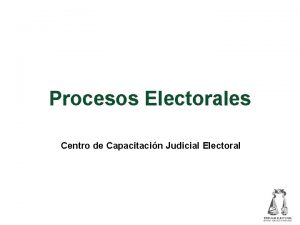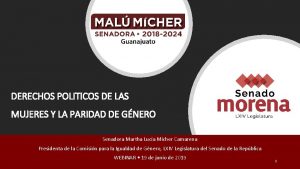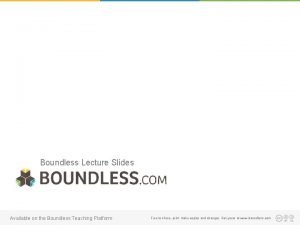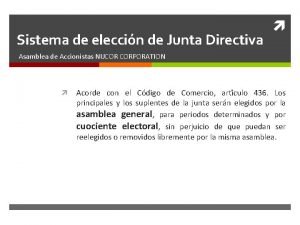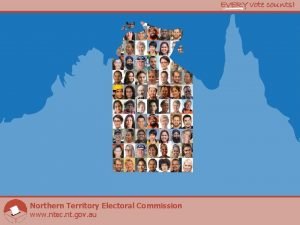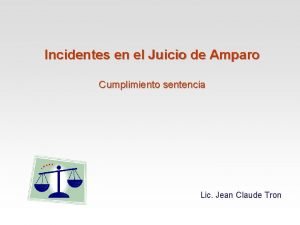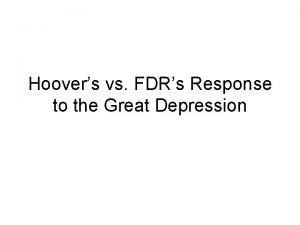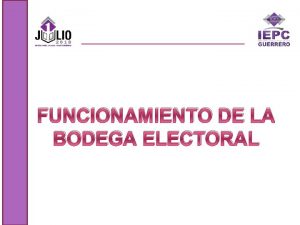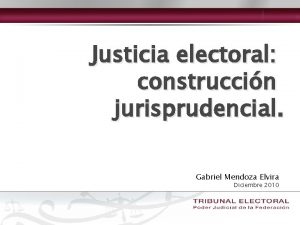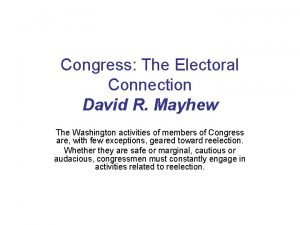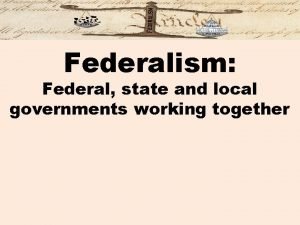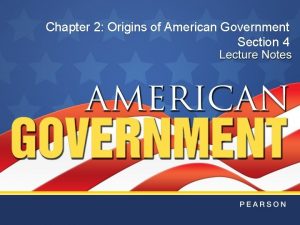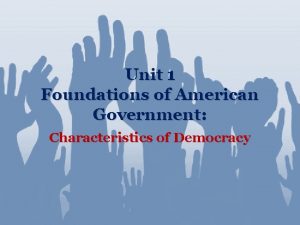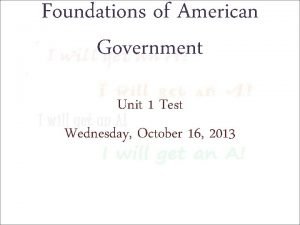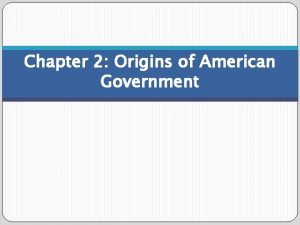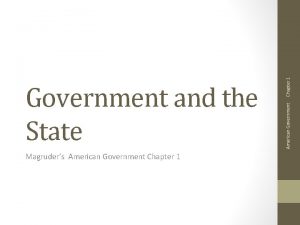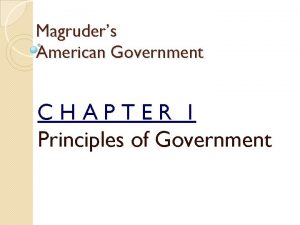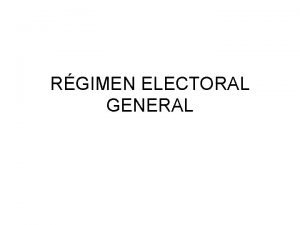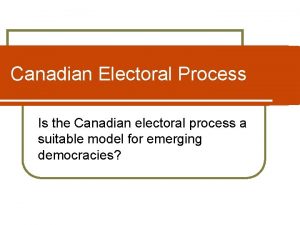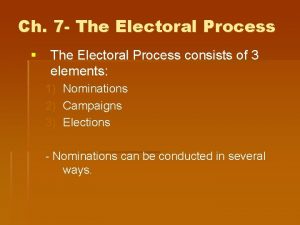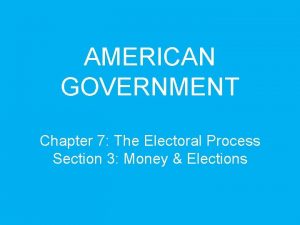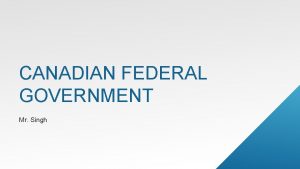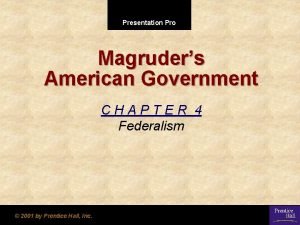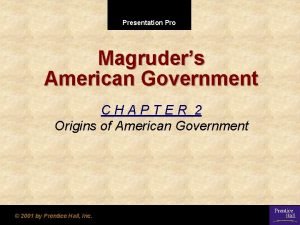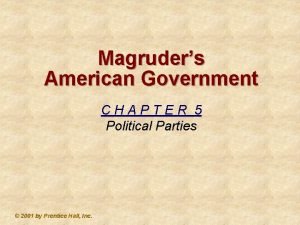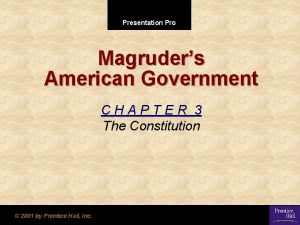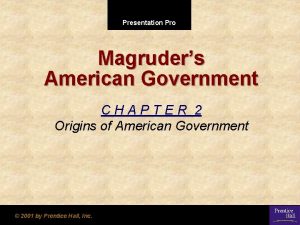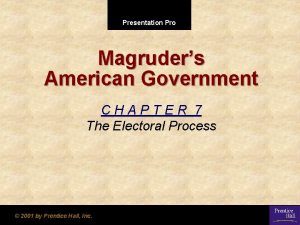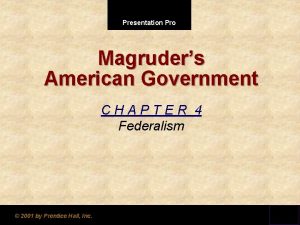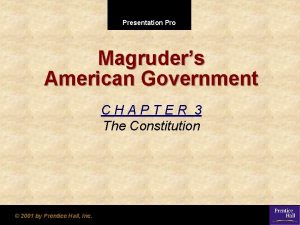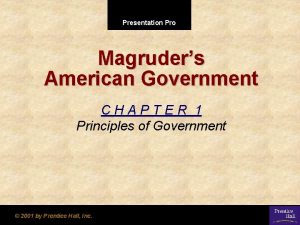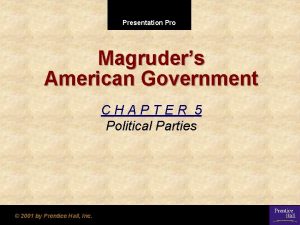Magruders American Government CHAPTER 7 The Electoral Process




![Why is nominating Important [*write down somewhere*] 1. 2. 3. It’s a major function Why is nominating Important [*write down somewhere*] 1. 2. 3. It’s a major function](https://slidetodoc.com/presentation_image_h2/e0dbe056a11a6c74ad5dabe34bdf3232/image-5.jpg)




























- Slides: 33

Magruder’s American Government CHAPTER 7 The Electoral Process

CHAPTER 7 The Electoral Process SECTION 1 The Nominating Process SECTION 2 Elections SECTION 3 Money and Elections 1 2 3 Chapter 7

SECTION 1 The Nominating Process • • Why is the nominating process a critical first step in the election process? What are self-announcement, the caucus, and the convention nominating methods? Why is the direct primary the principal nominating method used in the United States today? Why do some candidates use the petition as a nominating device? 2 3 Chapter 7, Section 1

A Critical First Step In the United States, the election process occurs in two steps: 1. Nomination, in which the field of candidates is narrowed 2. General election, the regularly scheduled election where voters make the final choice of officeholder 2 3 Chapter 7, Section 1
![Why is nominating Important write down somewhere 1 2 3 Its a major function Why is nominating Important [*write down somewhere*] 1. 2. 3. It’s a major function](https://slidetodoc.com/presentation_image_h2/e0dbe056a11a6c74ad5dabe34bdf3232/image-5.jpg)
Why is nominating Important [*write down somewhere*] 1. 2. 3. It’s a major function of political parties Reason for the decentralized character of major parties Nominations place a real and practical limits on the choices that voters can make in an election

1 -4 Years Before Election • first steps for potential candidates • include broadening their visibility, • testing their appeal nationwide, and • developing committees to explore • their viability as a candidate. If • the results are encouraging, the • contender will officially announce his • or her candidacy. 1 -4 Years Before Election • The costs of running for office • are huge and raising funds is an • ongoing effort throughout the • campaign. Lack of funds often • cause contenders to drop out of • the race. Start the Race Fundraising January–June of the Election Year Primaries and caucuses help determine • the party’s nominee. At this stage, voters • choose their party’s frontrunner and many • candidates concede defeat. Primaries and Caucuses

• Caucus • Self. Announcement • Conventio n • Nominatin g methods • Petition • Direct • Primary

Ways to Nominate Self-Announcement: 1. • • • person who wants to run for office simply announces that fact Oldest form of the nominating process May be used by someone who failed to win a regular party’s nominating or by someone unhappy with the party’s choice Examples: George Wallace of the American Independent Party in 1968 Eugene Mc. Carthy, Independent in 1976 John Anderson in 1980 Ross Perot in 1992 2 3 Chapter 7, Section 1

2. Petition: local level in American politics- candidates are nominated by petitions signed by a certain number of qualified voters in the election district • Minor party and independent candidates are usually required by State law to be nominated by petition. • Petition is often used at the local level to nominate for school posts and municipal offices.

18 months. Before presidential elections: parties send out a “Call to Convention”- asking states to meet to select presidential nominations and select delegates they will send to the national party convention…two methods: Caucuses & Primaries Both lead up to the convention

3. Caucuses Caucus: closed meeting of like-minded people who meet to select the candidate they will support , the caucus as a nominating device fell out of favor in the 1820 s Held locally and they choose delegates to a local convention ◦ @ the local convention, chose delegates to the state convention ◦ @ the state convention, chose delegates to the national convention • Analyzing Political Cartoons The first delegate-selection event in a presidential election by caucus is held in Iowa, followed afterward by the first scheduled primary in New Hampshire.

4. Primaries State convention meetings with 2 Purposes: • voters select delegates from their states to attend the national party convention • Vote to nominate a presidential candidate for their party or show preference for a presidential candidate This is preferred because it allows people to decide on candidates for presidency and nominees have to work hard to get support. 2008: 40 states used presidential primary system 16 states hold their primaries on ‘Super Tuesday’= February 5 th 3/4 ths of states hold their primaries in mid-March

Two kinds of primaries: Winner-Take-All vs. Proportional Representation In winner-take-all states, the delegates are awarded only to the candidate who wins the preference vote. 40% of vote = 0 delegates 60% of vote =100% delegate In a state with proportional representation, delegates are awarded to those candidates who win at least 15% of the vote. 40% of vote = 40 % delegates 60% of vote =100% delegate

Each state/territory has an assigned number of delegates it can send to the convention based on population/voting patterns/ # of congressional representatives and state government officials that are members of that party ◦ Democrats ◦ Send: 5, 552 to national convention ◦ ◦ Republicans ◦ Send: 2, 286 to national convention publicans

August–September of the September–November of November on the Tuesday after the first Election Year Delegates to the Election Year Following • each party’s convention adopt • the conventions, each candidate Monday in November, the voters cast their • the party platform, nominate their • focuses on his or her opponent. • ballots and the president • party’s presidential candidate, • Debates provide opportunities • and ratify his or her choice of • to compare and contrast each elect is determined • candidate’s qualifications and • vice-presidential running mate • plans for the future. . . National Conventions Debates Election Day

5. Conventions • • Parties select host city [look for arenas, stadiums, and sporting venues] 2016 Republican NC: wanted seating capacity of 25, 000 2016 Democratic NC: wanted seating capacity of 84, 000 Goals of National convention: 1. Name party’s presidential/vice presidential candidate 2. Promote party unity 3. Adopt party platform

Agenda of Convention 1. 2. • • 3. Choose Vice Presidential candidate- they give acceptance speech “Roll call of the states”= call states in alphabetical order [Alabama to Wyoming] Each complete roll call of states A-Z is called a ballot Each State spokesperson gives a speech about the state’s history/geography/its famous people… then announces its “delegate count” or choice for president Candidate usually wins party’s nomination on the 1 st ballot…if no one gets majority of votes, chairperson calls for a 2 nd ballot Nominee for that party gives Acceptance Speech

Nominating and Electing a Candidate 2 3 Chapter 7, Section 1

Section 1 Review 1. The most commonly used method of nomination today is ◦ ◦ (a) the caucus. (b) the direct primary. (c) self-announcement. (d) the convention. 2. A runoff primary is held in some States when ◦ (a) no one wins a majority of votes. ◦ (b) there is only one candidate. ◦ (c) not enough voters turn out on election day. ◦ (d) a candidate asks for a recount. 2 3 Chapter 7, Section 1

SECTION 2 Elections How does the administration of elections in the United States make democracy work? What role do precincts and polling places play in the election process? In what ways can voters cast their ballots? What role do voting machines and other innovations play in the election process? 1 3 Chapter 7, Section 2

The Administration of Elections are primarily regulated by State law, but there are some overreaching federal regulations. Congress has the power to set the time, place, and manner of congressional and presidential elections. Congress has chosen the first Tuesday after the first Monday in November of every even-numbered year for congressional elections presidential election being held the same day every fourth year. Help America Vote Act: upgrade voting machines, training of election officials, computerize registration Allow absentee voting: people can vote without going to polling place on election day through the mail 1 3 Chapter 7, Section 2

Precincts and Polling Places A polling place is where the voters who Precincts live in a precinct go to vote. A precinct is a voting district. It is located in or near Precincts are the smallest each precinct. Polling geographic units used to places are supposed to be located carry out elections. A precinct election board conveniently for voters. supervises the voting process in each precinct. 1 3 Chapter 7, Section 2

Casting the Ballot History of the Ballot Voting was initially done orally. It was considered “manly” to speak out your vote without fear of reprisal. Paper ballots began to be used in the mid-1800 s. In the late 1800 s, ballot reforms cleaned up ballot fraud by supplying standardized, accurate ballots and mandating that voting be secret. 1 3 Chapter 7, Section 2

Office-Group and Party-Column Ballots All candidates of the same Party are grouped together u Under title of office. 1 3 Lists candidates under Party’s name. Chapter 7, Section 2

Voting Machines and Innovations • Electronic vote counting has been in use since the 1960 s that reads ballots like a Scantron machine scans your votes and records them • Vote-by-mail elections have come into use in recent years. • Online voting is a trend that may be encountered in the near future. 1 3 Chapter 7, Section 2

Section 2 Review 1. Elections are held on ◦ ◦ (a) the first Wednesday after Halloween. (b) the first Tuesday after the first Monday in November. (c) the second Thursday after the first Monday in March. (d) the first Monday in December. 2. The Office-Group Ballot encourages ◦ ◦ (a) voter fraud. (b) split-ticket voting. (c) voter dissatisfaction. (d) the Democratic Party. 1 3 Chapter 7, Section 2

SECTION 3 Money and Elections What are the issues raised by campaign spending? What are the various sources of campaign funding? How do federal laws regulate campaign finance? What role does the Federal Election Commission have in enforcing campaign finance laws? What loopholes exist in today’s campaign finance laws? 1 2 Chapter 7, Section 3

Campaign Spending 1 2 Chapter 7, Section 3

Sources of Funding Private and Public Sources of Campaign Money Nonparty groups such as Small contributors: $5$100 Wealthy supporters: large donations Candidates: spend own money. . Ross Perot spend $65 to run as independent president in 1992 1 2 Political Action Committees [PACs]: special-interest groups who support a candidate Temporary fund-raising organizations Government Subsidy: grants of money from the government Chapter 7, Section 3

The Federal Election Commission (FEC) enforces: the timely disclosure of campaign finance information limits on campaign contributions – Cant give more than $1, 000 in a primary – Cant give more than $5, 000/yr to a PAC – Cant give more than $20, 000 to a party committee limits on campaign expenditures provisions for public funding of presidential campaigns 1 2 Chapter 7, Section 3

Loopholes in the Law “More loophole than law…” —Lyndon Johnson Hard money- contributions given directly to candidates for their campaigns for Congress or White House. . they’re limited and must be reported Soft money— unlimited money given to State and local party organizations for “party-building activities” [like voter registration] but end up being used for presidential or congressional campaigns… • $500 million was given to campaigns in this way in 2000. 1 2 Chapter 7, Section 3

Independent campaign spending—a person unrelated and unconnected to a candidate or party can spend as much money as they want to benefit or work against candidates. Issue ads—take a stand on certain issues in order to criticize or support a certain candidate without actually mentioning that person’s name. Negative Issue Ad by Move. On. org: President Bush Can't Think of a Mistake, 2004 (0: 29) Negative Issue Ad by Move. On. org: The Corporation's Choice, 2004 (0: 30) Negative Issue Ad by Swiftboat Veterans for Truth: Christmas in Cambodia, 2004 (0: 31)

Section 3 Review 1. ◦ ◦ Sources of campaign funding include (a) nonparty groups, such as political action committees. (b) government subsidies. (c) candidates’ personal funds. (d) all of the above. 2. Under federal election legislature passed in the 1970 s, candidates are not allowed to ◦ ◦ (a) take government subsidies. (b) use their own money in campaigns. (c) take contributions of more than $1, 000. (d) all of the above. 1 2 Chapter 7, Section 3
 Magruder's principle
Magruder's principle Chapter 7 the electoral process
Chapter 7 the electoral process Chapter 2 american government
Chapter 2 american government Chapter 2 origins of american government vocabulary
Chapter 2 origins of american government vocabulary Chapter 2 origins of american government answer key
Chapter 2 origins of american government answer key Chapter 2: origins of american government worksheet answers
Chapter 2: origins of american government worksheet answers Origins of american government chapter 2
Origins of american government chapter 2 Chapter 2 origins of american government
Chapter 2 origins of american government Chapter 4 federalism answer key
Chapter 4 federalism answer key The 1964 electoral map above illustrates the
The 1964 electoral map above illustrates the Machine selection
Machine selection Geografía electoral
Geografía electoral Lewisham electoral roll
Lewisham electoral roll Geografía electoral
Geografía electoral Materia electoral
Materia electoral Electoral college changes
Electoral college changes 1992 electoral map
1992 electoral map Compromise
Compromise Ejemplo cuociente electoral junta directiva
Ejemplo cuociente electoral junta directiva Territory
Territory Tipos de incidentes en materia electoral
Tipos de incidentes en materia electoral 1932 electoral map
1932 electoral map Ipeeg
Ipeeg El flujograma de documentos electorales es
El flujograma de documentos electorales es Gabriel mendoza elvira
Gabriel mendoza elvira Electoral connection definition
Electoral connection definition Cuerpo electoral significado
Cuerpo electoral significado National powers
National powers Origins of american government section 4
Origins of american government section 4 Unit 1 study guide government
Unit 1 study guide government Unit 1 foundations of american government
Unit 1 foundations of american government Origins of american government section 1
Origins of american government section 1 Foundations of american government unit 1 test review
Foundations of american government unit 1 test review Origins of american government section 1
Origins of american government section 1

